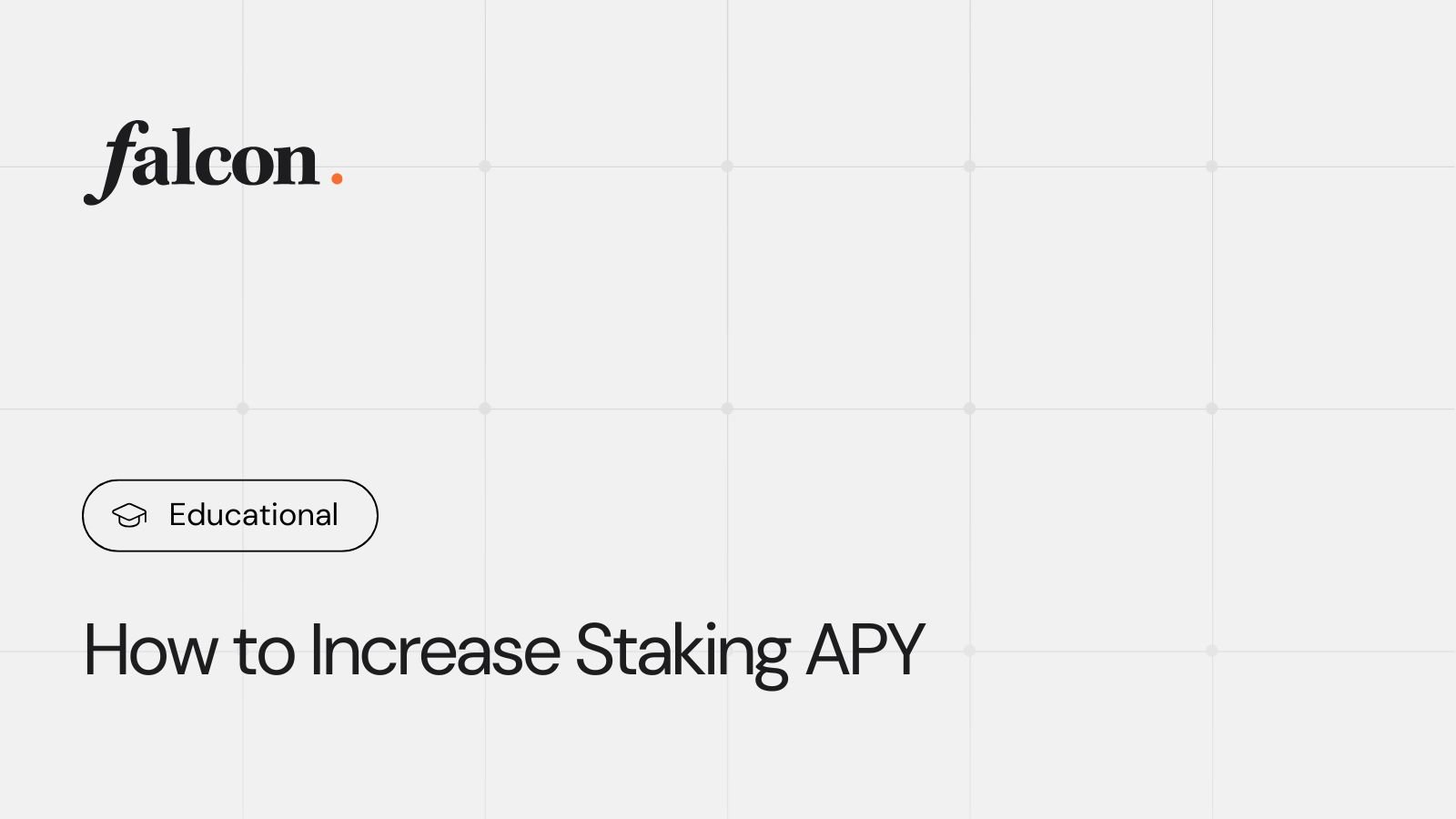Falcon Finance’s Staking Explained: How to Increase and Maximize APY
Updated • 15 Aug 2025
Published • 16 May 2025
5 mins

Cryptocurrency holders strive to generate a sufficient return. Stablecoins bring in a steady income stream, yet dollar-pegged assets’ earning rate hardly exceeds the Federal Reserve rate, ranging between 4.5-6% (as of June 2025). Staking altcoins and using DeFi farming mechanisms can generate income faster, but carry bigger price volatility risks. This is where Falcon Finance steps in with its synthetic dollar app: those staking in the protocol can get competitive earning rates thanks to institutional-grade strategies.
And that is only half the story: APY in Falcon can be further elevated using the feature called Boosted Yield. This article guides you through Boosted Yield’s offering and available options for maximizing returns.
Base Yield: Flexible Staking
Earning yield in Falcon Finance involves its dual-token system: the synthetic dollar, USDf, and the yield-bearing token, sUSDf. After minting USDf tokens with your collateral in the app, you stake it to receive sUSDf, which is used for distributing yield automatically accruing from the active strategies. The standard option for staking is called “Classic Yield.” It is flexible: you can unstake your sUSDf anytime, and then swap it into any of the eligible cryptocurrencies (for these operations, Falcon applies a 7-day cooldown period).
However, for users aiming for higher returns, Falcon Finance provides an avenue to increase the APY rate through Boosted Yield.
Boosted Yield: Unlocking Higher APY
Boosted Yield is a feature that allows Falcon Finance users to earn a higher APY by restaking their sUSDf for a fixed lock-up period. By committing your funds for a set duration, you receive a percentage “boost” on top of the base yield rate, offered in Classic Yield.
When you opt for a boosted position with Boosted Yield, Falcon mints a unique ERC-721 NFT that represents your staked sUSDf and the details of your lock-up term, which is another blockchain-based solution, used in Falcon alongside ERC-4626 token vaults.
Why Does Boosted Yield Offer Better Returns?
The logic behind the boosted yield in Falcon Finance is straightforward: when users lock their sUSDf for a fixed term, it provides the protocol with greater certainty for capital allocation. This stability allows Falcon Finance to deploy the locked capital into more sophisticated, time-sensitive yield strategies that can generate higher earnings. Essentially, users are rewarded with an enhanced APY in exchange for providing Falcon with more predictable capital management.
Options for Increased APY with Falcon’s Boosted Yield
Falcon Finance offers several tiers for its Boosted Yield feature, with longer lock-up periods providing progressively higher yield boosts. Here are the currently available lock-up terms:
- 3 months: 105% of the base rate.
- 6 months: 125% of the base APY.
- 12 months: a 150% boost to the base yield rate.
It is important to note that, while the underlying base yield rate of Falcon Finance fluctuates with the protocol’s performance and market conditions, the percentage boost you select remains active for the entire duration of your chosen lock-up term.
Calculating Returns in Boosted Yield vs. Classic Yield
To illustrate the impact of the Boosted Yield feature, let’s assume the base APY in Falcon Finance is 10%.
By staking 1,000 USDf (equivalent to $1,000) in Classic Yield without a lock-up would target the 10% base APY. It means that in a year after locking up crypto in Falcon, you would get 1,100 USDf tokens worth $1,100.
Boosted Yield’s returns would be higher:
- By choosing the 3-month option, your APY would effectively become 10.5%, turning an investment of 1,000 USDf into approximately 1,105 USDf in a year.
- Opting for the 6-month term boosts your APY to 12.5%, bringing the same amount of capital up to 1,250 USDf at the end of the same period.
- A one-year commitment boosts your effective APY to 15%, growing 1,000 USDf to 1,500.
Overall, Boosted Yield would cater more to patient long-term investors who are ready to commit their capital for longer periods of time for a better outcome in the end.
What Happens After the End of the Lock-Up
Once your chosen lock-up period matures, you can redeem your NFT to reclaim your sUSDf,
which will have accrued yield at the boosted rate. You don’t need to do it manually: everything is done intuitively in Falcon Finance’s interface once you connect your Web3 wallet to the app. After getting sUSDf, you can either stake them again using lock-up with Boosted Yield or a more flexible Classic Yield, or exchange tokens back to USDf, reflecting your initial principal plus the total yield earned.
Closing Thoughts
Falcon Finance has options for different investment strategies. If you always seek and try new investment opportunities, relying on short-term gains, or if you want to try Falcon out before locking up your crypto for longer periods, then Classic Yield could be the optimal choice. However, if you are ready to compromise locking up your crypto capital in the app for a longer term to receive higher returns in the future, then you should definitely pick Boosted Yield. Choose an investment path that would fit you the most!